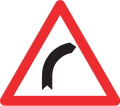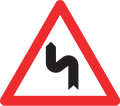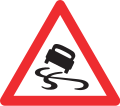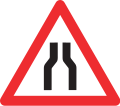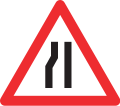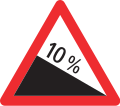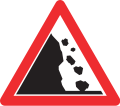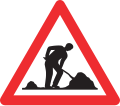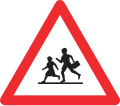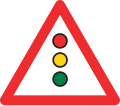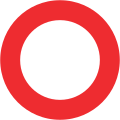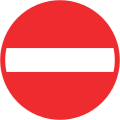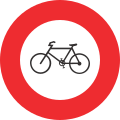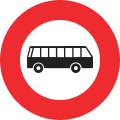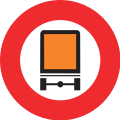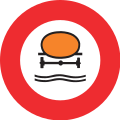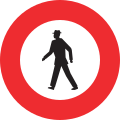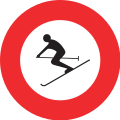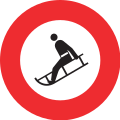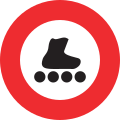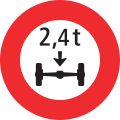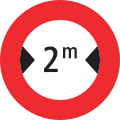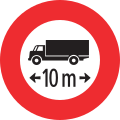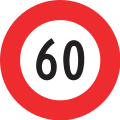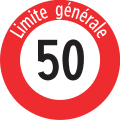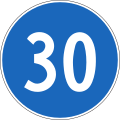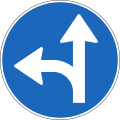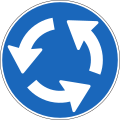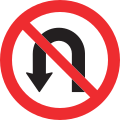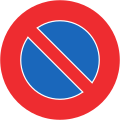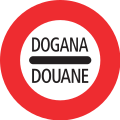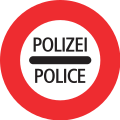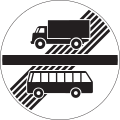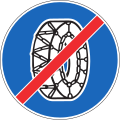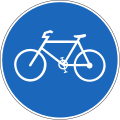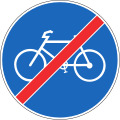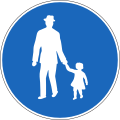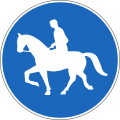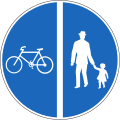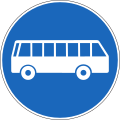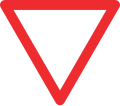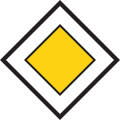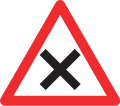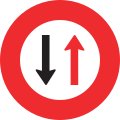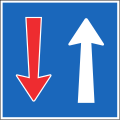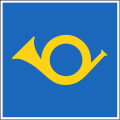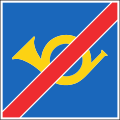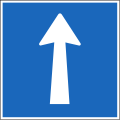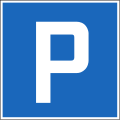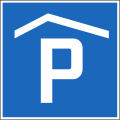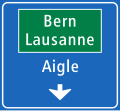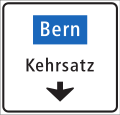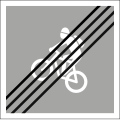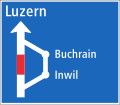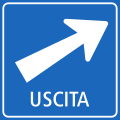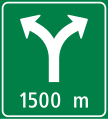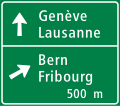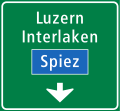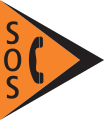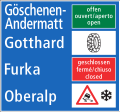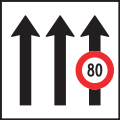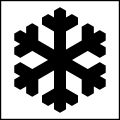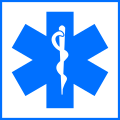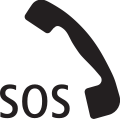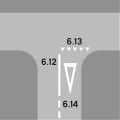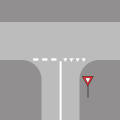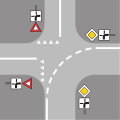Road signs in Switzerland and Liechtenstein
This article may require copy editing for grammar, style, cohesion, tone, or spelling. (June 2023) |
This article is written like a manual or guide. (January 2024) |
Road signs in Switzerland and Liechtenstein generally conform to the 1968 Vienna Convention on Road Signs and Signals.[1]

Although Switzerland is not a member of the European Union, the road signs largely follow the general European conventions concerning the use of shape and color to indicate their function. However, this is only a general pattern, as there are several exceptions.
Switzerland signed the Vienna Convention on Road Signs and Signals on November 8, 1968 and ratified it on December 11, 1991.[2] On March 2, 2020 Liechtenstein acceded to the Convention.
Concepts
Legal basis
The Swiss road signs are defined in the Road Signs Act, which is based on several laws and ordinances. Liechtenstein largely follows the legislation of Switzerland.
The major laws are:
Swiss laws
| SR/RS No. | Title | de | fr | it | ref |
|---|---|---|---|---|---|
| 741.21 | Road Signs Act | Signalisationsverordnung vom 5. September 1979 (SSV) | Ordonnance du 5 septembre 1979 sur la signalisation routière (OSR) | Ordinanza del 5 settembre 1979 sulla segnaletica stradale (OSStr) | [3] |
| 741.01 | Road Traffic Act | Strassenverkehrsgesetz vom 19. Dezember 1958 (SVG) | Loi fédérale du 19 décembre 1958 sur la circulation routière (LCR) | Legge federale del 19 dicembre 1958 sulla circolazione stradale (LCStr) | [4] |
| 741.11 | Road Traffic Rules Act | Verkehrsregelnverordnung vom 13. November 1962 (VRV) | Ordonnance du 13 novembre 1962 sur les règles de la circulation routière (OCR) | Ordinanza del 13 novembre 1962 sulle norme della circolazione stradale (ONC) | [5] |
| 725.111 | National Roads Act | Nationalstrassenverordnung vom 7. November 2007 (NSV) | Ordonnance sur les routes nationales du 7 novembre 2007 (ORN) | Ordinanza sulle strade nazionali del 7 novembre 2007 (OSN) | [6] |
Laws of Liechtenstein
| No. | Title | de | ref |
|---|---|---|---|
| 741.21 | Road Signs Act | Strassensignalisationsverordnung (SSV) vom 27. Dezember 1979, LGBl. 1978 Nr. 18 | |
| Road Traffic Law | Strassenverkehrsgesetz (SVG) vom 30. Juni 1978, LGBl. 1978 Nr. 18 | ||
| Road Traffic Rules Act | Verkehrsregelnverordnung (VRV) vom 1. August 1978, LGBl. 1978 Nr. 19 |
Language
Each canton is responsible for the management and placement of its road signs and complementary panels and uses one of the four official languages of Switzerland accordingly.
Metrics
Distances and other measurements are displayed in metric units.
Categorization and design
| Category | Shape | No. | Character | (Major) colour of | Example(s) | ||
|---|---|---|---|---|---|---|---|
| border | background | content | |||||
| Warning | triangular | 1.01–1.32 | Conducting | red | white | black | |
| Regulatory | circular | 2.01–2.20 | Prohibitive | red | white | black | 
|
| 2.30–2.65 | Commanding | white (thin) red |
blue white |
white black |
  | ||
| Priority | various | 3.01–3.25 | various |  
| |||
| Indication | rectangular | 4.01–4.25 | Conducting | white (thin) | blue | white & black | 
|
Routing 4.27–4.77.2 |
minor route minor road |
black (thin) | white | black | |||
| particular purpose | |||||||
| main route main road |
white (thin) | blue | white | ||||
| motor-/expressway 4.60–4.73 |
white (thin) | green | white | 
| |||
| detour route | black (thin) | orange | black | ||||
| commercial direction | black (thin) | grey | black | ||||
| bicycle route, mountain bike route, vehicle-like transport means route |
white (thin) | falu red | white | ||||
| 4.79–4.95 | Informational | white (thin) | blue | white | 
| ||
| Complementary Panels | rectangular | 5.01–5.58 | Compulsory | black (thin) | white | black |  |
| Road Markings | various | 6.01–6.31 | none | - | white yellow blue red |

| |
| Traffic Lights | circle cross arrows |
- | Commanding | white | black | red yellow green |
|
| Police Instruction Signs | - | - | - | - | - | ||
Starting in 2003, the font
Signs
Warning signs
-
1.01 Bend to right
-
1.02 Bend to left
-
1.03 Double bend, first to right
-
1.04 Double bend, first to left
-
1.05 Slippery road (e.g. black ice; panel 5.13 can be added, if there is black ice or slippery snow on road)
-
1.06 Uneven road
-
1.07 Road narrows on both sides (panel 5.15 can be added to indicate the width of the lane/road)
-
1.08 Road narrows on right
-
1.09 Road narrows on left
-
1.10 Steep gradient downwards
-
1.11 Steep gradient upwards
-
1.12 Loose chippings
-
1.13a Danger of falling rocks from the right
-
1.13b Danger of falling rocks from the left
-
1.14 Road works
-
1.15 Level crossing with barrier or gate (panel 5.12 can be added, if regulated by turn signals)
-
1.16 Railway level crossing without gate or barrier (traffic user is responsible to check optional approaches of trains!; panel 5.12 can be added, if regulated by turn signals)
-
1.17 (deprecated) Countdown (3–2–1) of level crossing ahead
-
1.18Chur, warning of street-running trains
-
1.22 Pedestrian crossing ahead (below 200 m ahead; only on non-urban roads in case of bad visibility; often panel 5.01 is added)
-
1.23 Presence of children (usually near schools and playing grounds or equals, slow down!)
-
1.24 Wild animals crossing
-
1.25 Animals on road (e.g. cattle)
-
1.25 Animals on road (e.g. horses)
-
1.26 Oncoming traffic
-
1.27 Traffic lights
-
1.28 (deprecated) Low-flying aircraft
-
1.29 (deprecated) Possible side winds
-
1.30 Other danger (additional information will be added below the sign, e.g. panel 5.16)
-
1.31 Congestion
-
1.32 Bicycle traffic/crossing
Regulatory signs
Prohibitions
-
2.01 Prohibition of all vehicular traffic in both directions
-
2.02 No entry for vehicular traffic (one-way street; possible exceptions for bicycles and mopeds must be indicated)
-
2.03 Prohibition of motor vehicles (on three or more wheels except for solo motorcycles, mopeds, and bicycles)
-
2.04 Prohibition of motorcycles
-
2.05 Prohibition of bicycles and mopeds
-
2.06 Prohibition of mopeds
-
2.07 Prohibition of large goods vehicles (total weight is larger than 3.5 t)
-
2.08 Prohibition of buses
-
2.09 Prohibition of trailers (of any kind, except for agricultural trailers)
-
2.09.1 Prohibition of trailers with exception for saddle and center axle trailers
-
2.10.1 Prohibition of vehicles carrying dangerous goods (always valid in tunnels)
-
2.11 Prohibition of vehicles carrying water pollutants
-
2.12 Prohibition of animals (horse and mare animals as well as the cattle drive)
-
2.13 Prohibition of motor vehicles and motorcycles
-
2.14 Prohibition of motor vehicles, motorcycles, and mopeds
-
2.15 Prohibition of pedestrians (includes any kind of vehicle-like transport means, e.g. rollerblades, skateboards, scooters, etc.)
-
2.15.1 Prohibition of skiing
-
2.15.2 Prohibition of sledging
-
2.15.3 Prohibition of any kind of vehicle-like transport means (such as rollerblades, scooters, skateboards, etc.)
-
2.16 Maximum weight (upper gross weight limit)
-
2.17 Axle weight (upper limit, axles closer than 1 meter apart count as one axle)
-
2.18 Maximum width (only produced if smaller than 2.55/2.60 m)
-
2.19 Maximum height (including payload; only produced, if lower than 4 m)
-
2.20 Maximum length (total length, including trailers)
Mandatory Instructions
-
2.30 Maximum speed limit (only valid during good condition, otherwise the driver must adjust speed to worse condition; ends with 2.53)
-
2.30.1 Generally valid speed limit within densely built-up areas (usually applied within the boundaries of a village or a town; ends with 2.53.1; German variant)
-
2.30.1 French variant
-
2.30.1 Italian variant
-
2.30.1 Romansh variant
-
2.31 Minimum speed limit (during good conditions (road, traffic, sight), the speed is not allowed to fall below the minimum speed limit; vehicles not capable of speeds exceeding 30 km/h are not allowed to continue; ends with 2.54)
-
2.32 Must turn right
-
2.33 Must turn left
-
2.34 Circumvent the obstacle on the right side
-
2.35 Circumvent the obstacle on the left side
-
2.36 Must continue straight ahead (see also 6.06)
-
2.37 Must turn right ahead (on motorways: must change to the right road; see also 6.06)
-
2.38 Must turn left ahead (on motorways: must change to the left road; see also 6.06)
-
2.39 Must turn right or left (see also 6.06)
-
2.40 Must continue straight ahead or turn right (see also 6.06)
-
2.41 Must continue straight ahead or turn left (see also 6.06)
-
2.41.1 Roundabout (must give yield to traffic in circle coming from left)
-
2.41.2 Mandatory direction for vehicles with dangerous goods
-
2.42 No right turn (not produced if sign 2.38 already defines the direction)
-
2.43 No left turn (not produced if sign 2.37 already defines the direction)
-
2.45 No overtaking by lorries (with a total weight larger than 3.5 t; ends with 2.56)
-
2.47 Minimum distance between large goods vehicles (total weight is larger than 3.5 t) required (if valid for a longer distance, then additional length information is shown below the sign: panel 5.03)
-
2.48 Snow chains required (metal snow chains must be applied to at least two wheels of the same axle; also valid for three-wheelers; ends with 2.57)
-
2.51 Customs (stop requested, except if no control is carried out, then speed limit is 20 km/h)
-
2.51 Latin languages variant
-
2.52 Police - must stop
-
2.52 Latin languages variant
-
2.53 End of maximum speed limit (ends 2.30)
-
2.53.1 End of generally valid speed limit (end of 2.30.1, German variant)
-
2.53.1 French variant
-
2.53.1 Italian variant
-
2.53.1 Romansh variant
-
2.54 End of minimum speed (end of 2.31)
-
2.55 End of no overtaking restriction (end of 2.44)
-
2.56 End of no overtaking by lorries restriction (end of 2.45)
-
2.56.1 End of part prohibition e.g. for lorries or buses (on lanes)
-
2.57 End of snow chain requirements (end of 2.48)
-
2.58 Free drive (end of previous restriction(s), general road rules apply again)
-
2.59.1a Start of area with a 30 km/h speed limit (especially careful driving is requested)
-
2.59.1e Start of area with generally applicable parking restrictions (here with applicable time constraints; Italian variant)
-
2.59.1c Start of parking area
-
2.59.2a End of area with particular speed limit
-
2.59.2e End of area with generally applicable parking restrictions (Italian variant)
-
2.59.2c End of parking area
-
2.59.3b Start of pedestrian area only (free for pedestrians and users of vehicle-like transport means, such as rollerblades, scooters, skateboards, etc.; if driving is exceptionally allowed then pedestrians and users of vehicle-like transport means have priority; Italian variant)
-
2.59.4b End of pedestrian area (Italian variant)
-
2.59.5a Start of Home zone (with 20 km/h speed limit, pedestrians and users of vehicle-like transport means, such as rollerblades, scooters, skateboards, etc., are allowed to use the entire street and have priority; parking only allowed at designated places; expect playing children in street!)
-
2.59.6a End of home zone
-
2.60 Bicycle path (users of bicycles and mopeds must use designated path; ends with 2.60.1; see also 6.09 and 6.26)
-
2.60.1 End of bicycle path (ends 2.60)
-
2.61 Pedestrian path (pedestrians must use designated path)
-
2.62 Bridleway (horsemen must use designated path with their horse)
-
2.63 Segregated and mandatory bicycle lane on the left and pedestrian lane on the right
-
2.63.1 Shared bicycle and pedestrian path (carefulness must be applied)
-
2.64 Exclusive public bus/transport lane (yellow Bus strips on road define the same (see 6.08); exceptions must be explicitly produced below sign)
-
2.65 Mandatory electric indicators above lanes (blocked lane – open lane – do change lane to the right!)
Priority signs
-
3.02 No priority/give way (only applicable, if junction/crossing is not controlled by working traffic lights; panels 5.01 and/or 5.09 can be added; see also 6.12–6.17)
-
3.03 Principal road with priority (Priority to the right rule does not apply; ends with 3.04; panel 5.09 can be added; see also see also 6.12–6.17)
-
3.04 End of principal road (the Priority to the right rule applies again; see also 6.12–6.17)
-
3.05 Crossing with a road without priority ahead (indicates priority on non-principal roads only; see also 6.12–6.17)
-
3.06 Crossroad with Priority to the right rule (only produced where situation could be unclear)
-
3.09 Give way to oncoming traffic (not applicable to narrow vehicles, such as bicycles, mopeds, single motorbikes, if there is enough space to cross)
-
3.10 Priority over oncoming traffic
-
3.20 Level crossing with double flashing lights
-
3.21 Level crossing with single flashing light
-
3.22 Level crossing location (indicating priority of trains!)
-
3.24 Level crossing location (indicating priority of trains!)
Indication signs
Conducting indication signs
-
4.01 Motorway (max speed limit 120 km/h, only motor vehicles are permitted which are capable of a speed of at least 80 km/h; overtaking only on the left side)
-
4.02 End of motorway
-
4.03 Expressway (often with oncoming traffic, max speed limit 100 km/h, only motor vehicles are permitted which are capable of a speed of at least 80 km/h; overtaking only on the left side)
-
4.04 End of expressway
-
4.05 Mountain postal road (priority given to public transport, such as postal bus; pay special attention to the specific three-tone-horn of the postal bus approaching hairpin bends and wait before the bend; traffic users must follow instructions given by public transport drivers)
-
4.06 End of mountain postal road
-
4.07a Announcement of tunnel with distance to tunnel entrance
-
4.08 One-way street
-
4.08.1 One-way street with oncoming traffic, here, of bicycles
-
4.09Dead end
-
4.09.1 Dead end with exceptions (here: bicycles and pedestrians)
-
4.10 Water protection area (traffic users must be particularly careful; range of validity may be shown)
-
4.11 Pedestrian crossing location (always produced on non-urban roads, in urban settings only, if badly visible; mandatory priority given to pedestrians – always applicable on any pedestrian crossings even w/o sign; see also 6.17–6.19)
-
4.12 Pedestrian underpass (mandatory)
-
4.13 Pedestrian overpass (mandatory)
-
4.14 Hospital (presence of hospital, rest home, or the like, traffic users must be particularly careful and must keep quiet, particularly during night time; see also 5.56)
-
4.15 Passing Place (designates a place, where a slower or downwards driving vehicle can let pass faster or oncoming traffic on steep/narrow/mountain roads (upwards driving vehicle has priority); however, voluntary stopping or parking is prohibited)
-
4.16 Breakdown place for accidental vehicles (motor must be turned off; however, voluntary stopping or parking is prohibited; panels 5.57 and 5.58 can be added)
-
4.17 Parking allowed (additional restriction and information may be published on another sign; if panel 5.14 is added, it indicates exclusive parking space for handicapped people; see also Parking markings)
-
4.18 Parking with parking disc (parking allowed while producing a clearly visible standardized parking disc (blue zone or red zone parking discs) showing arrival time; additional restrictions may be published on another sign; see also Parking markings)
-
4.19 (deprecated) End of parking area with parking disc (see also Parking markings)
-
4.20 Charged parking (additional requirements and restrictions may be published on the parking meter; if parking meter returns a parking slip, this slip must be produced clearly visible behind the windshield; if absolute parking time is limited, further payments or move of vehicle onto another space is prohibited)
-
4.21 Parking house (covered parking places)
-
4.22 Distance and direction of a parking possibility
-
4.23 Distance and direction for particular kinds of vehicles (here: lorries; see panels 5.20–5.52))
-
4.24 Emergency lane (with gravel pit (red); to be used in case of brake failure)
-
4.25 Park and ride (parking with access to public transport)
-
4.25 Covered Park and ride
-
4.25 Park and ride with access to train
-
... with access to tram
-
... with access to bus
Routing indication signs
... on main and minor roads
-
4.27 Entry of town/village on main road (often accompanied with a speed limit, normally requesting the generally valid speed limit of 50 km/h (see 2.30.1))
-
4.27 Entry of town/village on main road in Liechtenstein
-
4.28 End of town/village on main road (mentions next village/town above and distance to next major place(s) below the horizontal line)
-
4.28 End of town/village on main road in Liechtenstein
-
4.29 Entry of town/village on minor road (often accompanied with a speed limit, normally requesting the generally valid speed limit of 50 km/h (see 2.30.1); after the sign 4.29 the generally valid speed limit is applicable with the start of a densely built-up area even without the production of sign no. 2.30.1!)
-
4.29 Entry of town/village on minor road in Liechtenstein
-
4.30 End of town/village on minor road (mentions next village/town above and distance to next major place(s) below the horizontal line)
-
4.30 End of town/village on minor road in Liechtenstein
-
4.31 Signpost to destination via motor-/expressway route
-
4.32 Signpost to destination via main route
-
4.33 Signpost to destination via minor route
-
4.34 Detour to destination to be followed
-
4.34.1 (Ongoing) detour (for all destinations)
-
4.35 Signpost in table format (indicating direction to Zürich on main route, to Basel via motor-/expressway, and to Luzern on minor route)
-
4.36 Announcement of junction on main road, or on minor road connecting main roads (here with left route announcing connection to motor-/expressway to Basel)
-
4.37 Announcement of junction on minor road
-
4.38 Announcement of junction on main road with two lanes
-
4.39 Announcement of junction on minor road with two separated lanes
-
4.40 Announcement of junction on main road with restriction for the left route (here: maximal width)
-
4.41 Lane routing on main road with route to Bern and Lausanne via motor-/expressway
-
4.42 Lane routing on minor road with route to Bern on main route
-
4.43 (deprecated) Routing information for corresponding left, middle, and right lane (directions are compulsory; see also 6.06)
-
4.45 Signpost for particular vehicle types (here: lorries) (see panels 5.20–5.52; often announced with 4.23)
-
4.46 Signpost to parking place (panels 5.20–5.32 can be added)
-
4.46.1 Signpost to park and ride (parking with access to public transport)
-
4.47 Signpost to campsite
-
4.48 Signpost to caravan site
-
4.49 Signpost to a company, exhibitions and comparable (usually to be found in industrial zones)
-
4.50.1 Recommended path for bicycles
-
4.50.2 (deprecated) Signpost for bicycle circuit
-
4.50.3 Recommended track for mountain bikes (mountain bikers must especially take care of pedestrians/hikers on the same track, signaling their approaching, and if necessary to halt)
-
4.50.4 Recommended path for vehicle-like transport means, such as rollerblades, scooters, skateboards etc.
-
4.50.5 Signpost indicating directions for a particular type (here for bicycles)
-
4.50.6 Signpost indicating directions for different types
-
4.51.1 Signpost indicating direction for particularly named/numbered route
-
4.51.1 Routing information for bicycle path
-
4.51.1 Routing information for mountain bike track
-
4.51.2 Announcement of a turn for a particular type (here: vehicle-like transport means)
-
4.51.3 (deprecated) Confirmation to be on a mountain bike track
-
4.51.3 (deprecated) Confirmation to be on a bicycle path
-
4.51.3 (deprecated) Confirmation to be on a particularly named/numbered route
-
4.51.4 End route of a particular type (here for mountain bike route)
-
4.52 Routing information (here: how to turn left after one block even though it is impossible to do so directly)
-
4.53 Announcement of a detour
-
4.54 Announcement of roundabout on main road (here: left exit also leads to connection with motorway)
-
4.55 Announcement of a branching road with a dangerous situation or restrictions (here: side road to the left 50 m ahead with the warning of the presence of a gated level crossing right after the turn)
... numbering
-
4.57 Main road number
-
4.59 Number for exits
-
4.59.1 Number for junctions
... on motorways and expressways
-
4.60 First announcement of next exit
-
4.61 Second announcement of next exit
-
4.62 Start of exit
-
4.63 Exit sign (in German)
-
4.63 Exit sign (in French)
-
4.63 Exit sign (in Italian)
-
4.64 Junction board
-
4.65 Distance board
-
4.66 Announcement of junction
-
4.67 First information about junction ahead
-
4.68 Second information about junction ahead
-
4.69 Routing information above lane
-
4.70 Direction to the next emergency call pillar
-
4.71 Distance to police station (in German)
-
4.71 Distance to police station (in French)
-
4.71 Distance to police station (in Italian)
-
4.72 Kilometer sign
-
4.73 Hektometer sign
... general
-
4.75 Information about road condition of passes and ski resorts (here, the Furka Pass road ahead: pass closed, open as far as Realp, snow on road or black ice)
-
4.76 Pre-Information about road condition and requirements of certain destinations: red means road is closed, green means road is open, the sign 2.48 means (metal) snow chains are required, sign 1.05 means snow on road or black ice)
-
4.77 Information about routing of lanes (reducing from three to two lanes – two lanes from the right join the one lane – left lane is derouted to the other side of the motorway)
-
4.77.1 Lane with restriction (here: maximal speed limit)
-
4.77.2 Release of the mud strip
Informational signs
-
4.79 Campsite
-
4.80 Caravan site
-
4.81 Telephone
-
4.82 First aid
-
4.83 Roadside assistance
-
4.84 Petrol/gas station (panels 5.01 and/or 5.17 are often added)
-
4.85 Hotel-Motel
-
4.86 Restaurant
-
4.87 Refreshments
-
4.88 Information Center
-
4.89 Youth hostel
-
4.90 Local radio information with MHz frequency for road condition and traffic information channel
-
4.91 Church services (here: Romansh variant)
-
4.92 Fire extinguisher
-
4.93 Generally valid speed limits for different categories of roads in Switzerland
-
4.94 Emergency exit distances (in tunnels you find them at least every 50 metres at a height of 1–1.5 m)
-
4.95 Emergency exit (right next to exit)
Complementary panels
General remarks:
- All signs and complementary panels can be combined with complementary panels for particular kinds of transport means.
- If accompanied with the words ausgenommen / Excepté / eccettuato (excluding) or gestattet / Autorisé / permesso (permitted), it means that the indicated kind of transport means are excluded from the regulation of the main sign.
- The sign bicycles (5.31) also includes mopeds with a designed maximal speed of 20km/h.
- Generally applicable complementary panels
-
5.01 Distance (to which the meaning of a sign applies)
-
5.02 Distance and direction
-
5.03 Range of validity (the range for which a danger, regulation, restriction, or an indication is valid)
-
5.04 Repetition (of an already valid regulation, restriction, or an indication; continues before and after the sign)
-
5.05 Start panel (indicates the start of a regulation for static traffic)
-
5.06 End panel (indicates the end of a regulation for static traffic)
-
5.07 Direction indicator (in order to clarify for which area a regulation is applied to; particularly applied to 2.60, 2.61, 2.62, if such a path must be used on the other side of the road; particularly applied to 2.50 and 4.17 in order to clarify the area at which parking is prohibited, or allowed, respectively)
-
5.08 dangerous curve are finding danger bend of chevrons add to 1.43 1.66 2.88 3.00
-
5.09 dangerous curve are finding danger bend of chevrons 1.67 1.76 1.99
-
5.09 The danger bend of barriers with square and rectangle Narrows be careful about makers 1.88 1.30 1.90 and 6.90
- Complementary panels for certain signs
-
5.09 Indication of the routing of a principal road (aka a road with priority; combined with 3.01, 3.02, 3.03; here: principal road turns right with two minor roads, one from left and one from straight ahead; see also 6.16.2 and 6.16.3)
-
5.10 Indicates exceptions of prohibition of stopping (combined with 2.49)
-
5.11 Indicates exceptions of prohibition of parking (combined with 2.50)
-
5.12 Turn signal (CH only; combined with 1.15 or 1.16)
-
5.13 Black ice on road (or slippery snow on road; combined with 1.05 in case of a such road condition)
-
5.14 Handicapped people (combined with 4.17 it designates exclusive parking spaces for handicapped people; corresponding parking card Parkkarte für behinderte Personen / Carte de stationnement pour personnes handicapées / Contrassegno di parcheggio per persone disabili must be produced clearly visible behind windshield)
-
5.15 Width of lane/road (combined with 1.07)
-
5.16 Shooting noise (CH only; combined with 1.30)
-
5.17 Distance to second next petrol/gas station (CH only; often combined with 4.84)
- Kinds of transport means
-
5.20 Light motor cars
-
5.21 Heavy motor cars
-
5.22 Large goods vehicles (lorries; total weight is larger than 3.5 t)
-
5.23 Lorries with trailer
-
5.24 Articulated lorries
-
5.25 Bus
-
5.26 Trailer
-
5.27 Caravan/Living trailer
-
5.28 Mobile motor home
-
5.29 Motor bikes
-
5.30 Mopeds
-
5.31 Bicycle (this panel combined with the term gestattet / Autorisé / permesso (permitted) and added below the sign 2.61 often used for heavily used school routes)
-
5.32 Mountain bikes
-
5.33 Bicycle pushing
-
5.34 Pedestrians
-
5.35 Trams or streetways
-
5.36 Tractors
-
5.37 Tanks
-
5.38 Groomers
-
5.39 Cross-country skiing
-
5.40 Skiing
-
5.41 Sledging
-
5.50 Airplanes/Airfield
-
5.51 Car transfer on train (CH only)
-
5.52 Car transfer on ferry (CH only)
- Special panels
-
5.53 Industrial and commercial area
-
5.54 Customs declaration only with Sichtdeklaration / dédouanement à vue / dichiarazione a vista (combined with 2.01 on lanes: only for vehicles of this type)
-
5.55 S-Traffic (combined with the term ausgenommen / Excepté / eccettuato (excluding) and below the sign 2.07 indicates an exception for vehicles with corresponding signs attached to them)
-
5.56 Hospital with emergency station (emergency station open 24 hours)
-
5.57 Emergency phone (can be combined with 4.16)
-
5.58 Fire extinguisher (can be combined with 4.16)
Road markings
- Markings
-
6.01 Security strip (white, solid)
Designates centre of carriageway or border of lanes; crossing, traversing, or passing over it by vehicles is strictly prohibited -
6.02 Double security strip (white, solid) & 6.03 Directing strip (white, broken)
6.02 separates driving directions on roads with 3 or more lanes (or expressways); crossing, traversing, or passing over it by vehicles is strictly prohibited
6.03 designates either centre of carriageway on two-lane roads, or separates lanes; crossing, traversing, passing over for overtaking is allowed; any change of lanes or overtaking manoeuvres (start and end) must always be indicated by flashing turn indicators! -
6.04 Double strip (combination of a security strip and a directing strip on either side of the security strip)
Designates the allowance to cross, pass, or traverse it, or to start an overtaking manoeuvre only from the side with the directing strip; always indicate such intentions by flashing turn indicators! -
6.05 Advance warning strip (white, closely broken)
Announces either security or double strips; overtaking manoeuvres must be finished -
6.06 Pre-selecting arrows (white)
Indicates lanes for directions; the chosen direction is compulsory (correspond with 2.31–2.36, see also 4.43)!
Yellow arrows indicate directions for public transport only and their directions can be different -
6.07 Pull arrows (white, arranged obliquely)
Orders to leave the lane into the indicated direction -
6.08 Bus lane (yellow, solid or broken strips; yellow word BUS)
Indicates exclusive lanes for public transport only (see also 2.64); exceptions must be indicated; may be crossed, if the yellow strip is a broken line; -
6.10 Stop line (white, wide, solid) & 6.11 STOP (white word, optional) & 6.12 Longitudinal strip (white, solid, optional)
Is always combined with stop sign (3.01), and can be combined with traffic lights, level crossing (3.20–3.25), and on lanes for turn off traffic; traffic user must halt in front of the stop line and give way; irrelevant while traffic lights are green; stop lines are yellow, if exclusively addressed to bicycles and mopeds (e.g. on bicycle paths and lanes; see also 6.26) -
6.13 Waiting line (white, small triangles in a row with spikes towards the arriving vehicle) & 6.14 Announcement of waiting line (white, large triangle, optional) & 6.12 Longitudinal strip (white, solid, optional)
Must give way; is always printed on roads at entries to motorways and expressways, and is usually announced by 6.14 on main roads and important minor roads; always accompanied by 3.02, and can be combined with traffic lights; irrelevant while traffic lights are working (not flashing or turned off); waiting lines are yellow, if exclusively addressed to bicycles and mopeds (e.g. on bicycle paths and lanes) -
6.15 Border strip (white, solid) & 6.16 Guidestrip (white, broken)
6.15 designates a carriageway's border;
6.16 optically guides the traffic -
6.16.1 Guidestrips (example 1) continue stop or waiting lines
... and separates the side road from the main road;
Guidestrips do not appear on side roads with valid Priority to the right rule (see also 3.06) -
6.16.2 Guidestrips (example 2) indicate the course of the principal road
... in cases of a principal road's turn with adjoining roads -
6.16.3 Guidestrips (example 3) can be replaced by stop or waiting lines
And (example 4), they also separate the carriageway from traffic zones of minor importance -
6.17 Pedestrian crossing (longitudinal, wide, yellow; on cobble stones if need be white) & 6.18 Prohibition of stopping strip
6.17 Traffic users approaching pedestrian crossings must always give way to pedestrians and safely stop, anywhere, if not orchestrated by working traffic lights (not flashing, or not turned off; see also 4.11);
6.18 It is prohibited to voluntarily stop next to 6.18 and on the sideway next to it; do not halt on pedestrian crossings, even not during rush hours (heavily fined!) -
6.19 Pedestrian area (yellow, two longitudinal strips on each side connected by bias bindings)
Exclusive area on roads for pedestrians -
6.20 Restricted area (white, shaded and framed)
optically guide traffic; strictly prohibited to be crossed, transferred, or driven over -
6.21 Zigzag bands (yellow)
Designates public bus stop area; prohibited to park; can be used for getting in and out of people, but only if public traffic is not obstructed at all -
6.22 Prohibition of parking strip (yellow, longitudinal strip broken with diagonal crosses)
-
6.23 Prohibition of parking area (yellow, framed, diagonally crossed, optional labelled with word TAXI or car license plate number)
Exclusive parking for designated traffic users; if labelled, it can be used for boarding, but only if valid traffic user is not obstructed at all -
Parking (usually framed by white, blue, red, or yellow solid strips)
Parking fields can be signposted (see 4.17–4.21) and / or framed by white (for free, if not signposted with 4.20; or 4.18), blue, or red solid strips (sometimes only indicated by partial markings); blue markings indicate Blue Zone parking spaces with parking disc/card (see #Blue Zone parking disc); red markings indicate Red Zone parking spaces (only existing in a few cantons); yellow parking spaces are reserved for private or special purposes (prohibited to be used by public);
In areas with parking markings, it is prohibited to park anywhere else; only use parking markings of appropriate size for bicycles/mopeds, motorbikes, cars, buses (indicated by word CAR), or lorries!
Blue Zones can be indicated by a thick white-blue crossline at the start and by thick blue-white crossline at the end of the zone -
6.25 Prohibition of stopping strip (yellow, longitudinal solid strip with endings)
Voluntarily stopping is prohibited next to this area -
6.26 Extended bicycle lane (waiting area placed in front of stop line with an additional yellow stop line and a bicycle icon in front of the white stop line)
During red traffic light bicycles and mopeds are allowed to wait in front of first motor vehicle and next to each other, motor vehicles must stop in front of the white stop line; when traffic light becomes green, motor vehicles must be patient and give way to bicycles and mopeds starting in front of them in order to let them cross the crossroad first! -
6.30 Guide post, right
... on roads with oncoming traffic on the right side; also on the left side of the carriageway on roads with, either separated directions, or without oncoming traffic. -
6.31 Guide post, left
... on roads with oncoming traffic on the left side.
Traffic lights
General Remarks:
- Working traffic light signals (not turned off or not flashing yellow) precede the priority signs, the road markings, and the general road rules.
- A yellow flashing traffic light warns of special caution, and the general road rules, priority signs, and road markings have to be applied and followed (in particular stop signs (see 3.01) or give way signs (see 3.02) and all other priority signs, or direction indications (e.g. see 2.32–2.43, 2.46, 6.06, 6.10, 6.13), and others)
- White traffic lights are addressed to public transport only.
General rules
- General signals
-
7.0.1 Usual vertical composition with red, yellow, and green from top to bottom; light signals are round
-
7.0.2 Horizontal composition with red, yellow, and green from left to right
-
7.01 Red light means "halt".
Valid for all road users as long as there are not additional traffic lights addressed to particular road users (e.g. bicycles and mopeds); motor vehicles must stop in front of the stop line (see 6.10, and especially 6.26), and motor vehicles usually turn off the engine in order to reduce air and sound pollution
Flashing red lights exists only at level crossings (see 3.20 and 3.21), and have the same meaning! -
7.02 Yellow and red light together is an indication to be ready to start again and to wait for the green light
Turn your engine back on, put in gear, and give way to bicycles/mopeds in front of you in the case of an extended bicycle lane (see 6.26) -
7.03 Green light releases the traffic.
Turning vehicles must give way to oncoming traffic and to pedestrians and users of vehicle-like transport means (such as rollerblades, scooters, skateboards, etc.) on side roads (usually traversing the side road on pedestrian crossings at the same time)! -
7.04 Yellow light (not flashing) follows the green light and vehicles have to stop, if it is still possible to do so in a reasonable manner
- ... with direction indication
-
7.10 Red light with direction indication, here: straight ahead (black outline figure of arrow(s))
Valid only for the (lane with) corresponding direction(s); indicated direction(s) are mandatory (corresponds with direction indication signs 2.32–2.41 and pre-selecting arrows 6.06 on road surface, if present) -
7.10.1 Red light with direction indication (example 2), here: wait for green light before turning to the right
-
7.11 Yellow light with direction indication, here: straight ahead
Valid only for the (lane with) corresponding direction(s) -
7.12 Green arrow, here: straight ahead (green arrow(s))
Permits traffic according to the indicated direction(s)
Valid only for the (lane with) corresponding direction(s); indicated direction(s) are mandatory (corresponds with direction indication signs 2.32–2.41 and pre-selecting arrows 6.06 on road surface, if present) -
7.12.1 Green arrow (example 2), here: turning to the left
Permits traffic turning to the left only -
7.12.2 Green arrow (example 3), here: turning to the right
Permits traffic turning to the right only -
7.13 Direction panel additionally indicates direction(s), here: straight ahead (black arrow(s))
Valid only for the (lane with) corresponding direction(s); indicated direction(s) are mandatory (corresponds with direction indication signs 2.32-2.41 and pre-selecting arrows 6.06 on road surface, if present) -
7.14.1 Green arrow with additional flashing yellow (example 1), here: turning to the left
Permits traffic turning to the left, but indicates that turning vehicles must give way to oncoming traffic and to pedestrians and users of vehicle-like transport means (such as rollerblades, scooters, skateboards, etc.) on side roads (usually traversing the side road on pedestrian crossings at the same time)! -
7.14.2 Green arrow with additional flashing yellow (example 2), here: turning to the right
Permits traffic turning to the right, but indicates that turning vehicles must give way to pedestrians and users of vehicle-like transport means (such as rollerblades, scooters, skateboards, etc.) on side roads (usually traversing the side road on pedestrian crossings at the same time)!
Specifically addressed
- ... to bicycles and mopeds
-
7.20 Addressed exclusively to bicycles and mopeds
All traffic light rules are valid to bicycles and mopeds as well, but can be exclusively addressed to them by showing a bicycle icon -
7.20.1 Alternative version with a panel
-
7.21 Direction panel exclusively addressed to bicycles and mopeds
-
7.21.1 Alternative version with a velo icon on the panel
Police instruction signs
Blue Zone parking disc
When parking in a Blue Zone, you should set and display a blue parking disc with the time of arrival according to the Blue Zone Rules. Parking in a blue zone space is limited to 1 hour unless otherwise indicated. When parking, make sure the whole vehicle, including bumpers, are within the marked parking space.
Blue disks are available in various places, such as the police station, hotels, tourist offices, newsstands, the local Gemeinde/Town hall, garages and gas stations.
Blue Zone Parking Rules
From Monday to Saturday
Set the disc to the exact time or the next half-hour mark if the exact time is not printed on the disc.
| Between | Parking Allowed |
|---|---|
| 8:00-11:30 | For 1 hour after set time |
| 13:30-18:00 | For 1 hour after set time |
| 11:00-13:30 | Until 14:30 |
| 18:00-19:00 | Until 09:00 the next morning |
| 19:00-07:59 | Blue disc is not needed if you leave by 08:00 |
From Saturday 18:00 until Monday 09:00 blue-zone parking is free. No need to set blue disc.
For Blue Zones marked with a 4 digit area code and you do not have the corresponding parking permit just follow regular Blue Zone parking rules. If you have a valid parking permit for the specific area code, parking is unlimited in these zones.
See also
References
- ^ "Convention on Road Signs and Signals Vienna, 8 November 1968". United Nations. Archived from the original on 3 June 2012. Retrieved 1 September 2012.
- ^ "United Nations Treaty Collection". treaties.un.org. Retrieved 2023-11-18.
- ^ "SR 741.21 Signalisationsverordnung vom 5. September 1979 (SSV)" (in German, French, and Italian). Berne, Switzerland: Swiss Federal Council. 15 January 2017. Retrieved 2017-08-07.
- ^ "SR 741.01 Strassenverkehrsgesetz vom 19. Dezember 1958 (SVG)" (in German, French, and Italian). Berne, Switzerland: Swiss Federal Council. 1 October 2016. Retrieved 2017-08-31.
- ^ "SR 741.11 Verkehrsregelnverordnung vom 13. November 1962 (VRV)" (in German, French, and Italian). Berne, Switzerland: Swiss Federal Council. 7 May 2017. Retrieved 2017-08-31.
- ^ "SR 725.111 Nationalstrassenverordnung vom 7. November 2007 (NSV)" (in German, French, and Italian). Berne, Switzerland: Swiss Federal Council. 1 January 2016. Retrieved 2017-08-31.
- NZZ(in German). Zurich, Switzerland. Retrieved 2017-06-28.
- ^ "Frutiger honored with SOTA award". Microsoft Typography. Retrieved 1 September 2012.

